Collection of materials relating to neuro-ophthalmology as part of the Neuro-Ophthalmology Virtual Education Library.
NOVEL: https://novel.utah.edu/
TO
- NOVEL717
| Title | Creator | Description | Subject | ||
|---|---|---|---|---|---|
| 201 |
 |
Emianopsia Omonima (Italian) | North American Neuro-Ophthalmology Society | This refers to an absence of vision towards one side of the visual world in each eye. The damage that caused this problem is in the brain and not in the eyes. | Homonymous Hemianopsia; Patient Brochure |
| 202 |
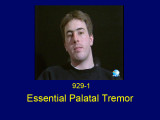 |
Essential Palatal Tremor | Shirley H. Wray, MD, PhD, FRCP | The patient is a 25 year old meteorologist from Tennessee who came to Boston in the summer of 1992 to vacation with his family on the Cape. His illness started with flu-like symptoms, low grade fever from 99 to 100F, sweating and episodes of light headedness associated with occasional nausea, indige... | Essential Palatal Tremor (Myoclonus); Brainstem Encephalitis |
| 203 |
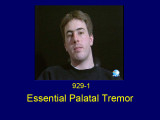 |
Essential Palatal Tremor | Shirley H. Wray, MD, PhD, FRCP | Slideshow describing condition. | Brainstem Encephalitis; Essential Palatal Tremor (Myoclonus) |
| 204 |
 |
Ethambutol Optic Neuropathy | Hailey Mair, BS; Padmaja Sudhakar, MD | This is a PowerPoint slide describing ethambutol induced optic neuropathy and it elaborates on mechanism and vulnearble population. | Ethambutol; Tuberculosis; Optic Neuropathy |
| 205 |
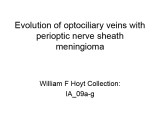 |
Evolution of Optociliary Veins with Perioptic Nerve Sheath | William F. Hoyt, PhD | Series of images showing progression of disc swelling and macular degeneration. Pathology: Optociliary Vein. Disease/Diagnosis: Perioptic nerve sheath meningioma evolution. Clinical notes: Visual Loss. | Optic Disc Atrophy with Special Features; Optociliary Veins; Shunt Vessels (Meningioma) |
| 206 |
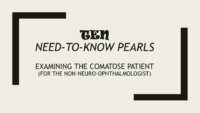 |
Examining the Comatose Patient for Non-Neuro-ophthalmologists | John Pula, MD | Seven need-to-know pearls for examining the pediatric patient, for non-neuro-ophthalmologists. | Comatose Patient Exam |
| 207 |
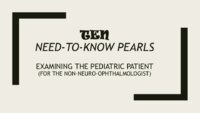 |
Examining the Pediatric Patient for Non-Neuro-ophthalmologists | John Pula, MD | Ten need-to-know pearls for examining the pediatric patient, for non-neuro-ophthalmologists. | Pediatric Patient Exam |
| 208 |
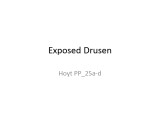 |
Exposed Drusen (PowerPoint) | William F. Hoyt, PhD | PP25a: Left eye: Severe visual field defect. PP25b: right eye with exposed drusen and field loss: visual field defects; PP25c: right eye visual field PP25d: left eye visual field. | Pseudopapilledema; Exposed Drusen |
| 209 |
 |
Eyebrow Spasm | Daniel J. Costello, MD | Slideshow describing condition. | Bipolar Affective Disorder; Epileptic Seizures; Primary Position Left Beating Nystagmus; Rhythmic Eyebrow Spasm; Torsional Nystagmus; Tuberous Sclerosis Complex (TSC-2 DNA sequence variant) |
| 210 |
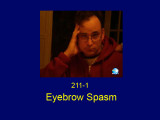 |
Eyebrow Spasm (Guest Lecture) | Shirley H. Wray, MD, PhD, FRCP | This case is published courtesy of Daniel J. Costello, M.D., Department of Neurology, Massachusetts General Hospital, Boston. The patient is a 32-year-old right-handed man with an established diagnosis of Tuberous Sclerosis Complex characterized by: -medically intractable epilepsy -developmental del... | Rhythmic Eyebrow Spasm; Torsional Nystagmus; Primary Position Left Beating Nystagmus; Epileptic Seizures; Tuberous Sclerosis Complex (TSC-2 DNA sequence variant); Bipolar Affective Disorder |
| 211 |
 |
Eyelid Myokymia | NANOS | Eyelid myokymia is a very common condition that many people have experienced at least briefly at one time or another, though the exact prevalence is not known. Myokymia is characterized by involuntary fine contractions or "twitching" of the eyelids. | Eyelid Myokymia; Patient Brochure |
| 212 |
 |
Eyelid Myokymia (Portuguese) | NANOS | Excessive or anomalous eyelid closure. | Eyelid Myokymia; Patient Brochure |
| 213 |
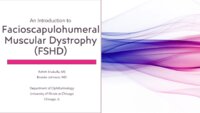 |
Facioscapulohumeral Muscular Dystrophy (FSHD) | Rohith Erukulla; Brooke Johnson | This is an introduction to Facioscapulohumeral Muscular Dystrophy (FSHD) and its causes, presentation, diagnosis, treatment, and ongoing related research. | Dystrophy; Facioscapulohumeral Muscular Dystrophy; FSHD; Myopathy |
| 214 |
 |
Facts About Ambulatory Care Accreditation | Joint Commission on Accreditation of Healthcare Organizations (JCAHO) | The Joint Commission's Ambulatory Care Accreditation Program was established in 1975, and today more than 2,000 freestanding ambulatory care organizations are Joint Commission-accredited. These organizations generally fall into the broad categories of surgical, medical/dental and diagnostic/therapeu... | Ambulatory Care Accreditation |
| 215 |
 |
Familial Amyotrophic Lateral Sclerosis | Shirley H. Wray, MD, PhD, FRCP | Slideshow describing condition. | Bulbar Palsy; CNS -Degeneration; Convergence Insufficiency; Familial Amyotrophic Lateral Sclerosis; Lou Gehrig's Disease; Saccadic Breakdown of Horizontal Pursuit; Slow Hypometric Horizontal Saccades; Superoxide Dismutase (SOD1) Gene; Supranuclear Paralysis of Up and Downgaze Degeneration |
| 216 |
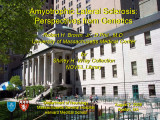 |
Familial Amyotrophic Lateral Sclerosis | Shirley H. Wray, MD, PhD, FRCP | This 58 year old woman was referred to Dr. Robert Brown in March 1995 for evaluation of slurred speech. She remained under his care until her death. On examination she had signs of a pseudobulbar palsy: Dysarthria and dysphagia Diminished palatal movement with positive gag bilaterally Diminished rap... | Supranuclear Paralysis of Up and Downgaze Degeneration; Convergence Insufficiency; Slow Hypometric Horizontal Saccades;; Saccadic Breakdown of Horizontal Pursuit; Bulbar Palsy; Familial Amyotrophic Lateral Sclerosis; Lou Gehrig's Disease; CNS -Degeneration; Superoxide Dismutase (SOD1) Gene |
| 217 |
 |
Fat Emboli | Kathleen B. Digre, MD; James J. Corbett, MD | Slideshow describing condition. | Emboli |
| 218 |
 |
Fibrin-Platelet Emboli | Kathleen B. Digre, MD; James J. Corbett, MD | Slideshow describing condition. | Emboli; Platelet Emboli |
| 219 |
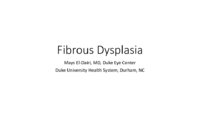 |
Fibrous Dysplasia | Mays El-Dairi, MD | Presentation covering an overview of fibrous dysplasia. | Fibrous Dysplasia |
| 220 |
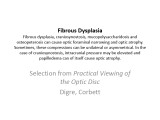 |
Fibrous Dysplasia | Kathleen B. Digre, MD; James J. Corbett, MD | Slideshow describing condition. | Dysplasia; Fibrous Dysplasia |
| 221 |
 |
Finger to Nose Perimetry | John Pula, MD | A description of the use of the finger to nose perimetry test is covered. | Non-organic Vision Loss |
| 222 |
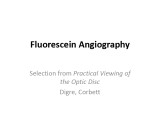 |
Fluorescein Angiography | Kathleen B. Digre, MD; James J. Corbett, MD | Fluorescein angiography in neuro-ophthalmology. | Fluorescein Angiography; History |
| 223 |
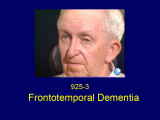 |
Frontotemporal Dementia | Shirley H. Wray, MD, PhD, FRCP | A PowerPoint slideshow describing the condition. | Acquired Ocular Motor Apraxia; Acquired Oculomotor Apraxia; CNS Degeneration; Complete paralysis of Voluntary Horizontal Saccades on Command to Look Left; Frontotemporal Dementia; Impaired Pursuit; Inability to Make a Refixation Saccade on Command to a Target Held on the Left; Normal Voluntary Hori... |
| 224 |
 |
Frontotemporal Dementia | Shirley H. Wray, MD, PhD, FRCP | The patient is a 68 year old right handed retired air conditioner repair man who presented with impaired balance and slow walking. For about one year he had noted difficulty lifting his feet high enough when climbing the stairs. From that time on, his movements slowed and worsened so that he had dif... | Saccadic Initiation Deficit of Unilateral Horizontal Gaze; Complete Paralysis of Voluntary Horizontal Saccades on Command to Look Left; Inability to Make a Refixation Saccade on Command to a Target Held on the Left; Normal Voluntary Horizontal Saccadic Eye Movements to the Right; Impaired Pursuit; F... |
| 225 |
 |
Frontotemporal Dementia: Overview and Neuro-ophthalmologic Features | Pavan Vaswani, MD, PhD; Ali G. Hamedani, MD, MHS | Objectives: Understand the diagnostic criteria for the frontotemporal dementias; Differentiate behavioral variant FTD and the common variants of primary progressive aphasia; Recognize neuro-ophthalmologic and imaging features seen in FTD syndromes | Frontotemporal Dementia |
